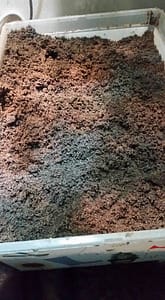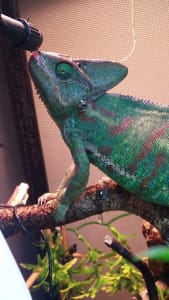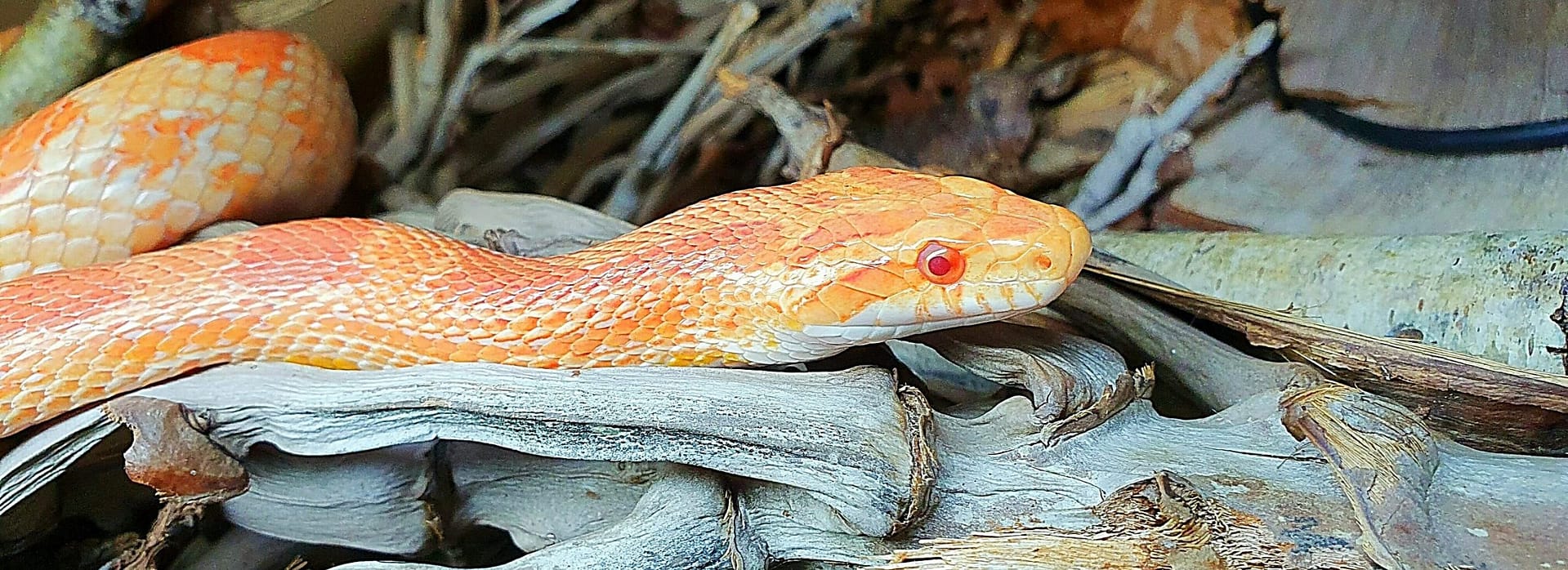*This article is an updated version of one of my own pieces with the same title printed in ‘Practical Reptile Keeping’ magazine, and on ‘Reptile Apartment’.
It was originally based around female Chameleons, but I have since updated it to be relevant to most female multiple egg laying Lizards.
But for me, I feel this is quite sad. These days, it’s totally unwarranted.
Many female Lizard species are not as popular due to related “egg laying” issues related to such. This is a Fact.
Any breeder will tell you, they get a healthy batch of babies, and it’s always the females who are last to go. Again, this is a fact.
But for me, I feel this is quite sad. These days, it’s totally unwarranted.
Finding Facts
We have better science within the hobby, that really does aid all elements of the keeping process.
I understand the reasoning, I really do. It is a worrying time for any keeper, and of course, the reptile species in question. But when you look at the evidence of captive bred lizards of any species having egg binding, or egg related issues over the past few years, it’s actually not bad at all.
If you are browsing social media, like a reptile Facebook group for example, or a reptile based forum, you will see a few disaster stories – but, this is because people are rarely going to post photos or updates of their Bearded Dragon (Pogona vitticeps) or Veiled Chameleon (Chamaeleo calyptratus) for example who has just laid her eggs successfully. It’s just not “interesting” enough.
But honestly – The amount of captive reptiles in the world, in comparison to the deaths/problems caused by the egg laying process, statistically, it’s very low. Ask your local exotic vet. You’ll be surprised I’m sure.
Simple reason being, we understand things better. We have better science within the hobby, that really does aid all elements of the keeping process.
So for our egg laying females, there are a few key improvements over the past few years;
Hydration:
We understand how vital hydration is for our reptiles, regardless of the sex or species.
A Female that is not hydrated sufficiently, may well ‘give up‘ the dig. Get tired. Of course, this causes delay of the lay. That’s a bad situation.
With the range of hydration options available today that can be utilised by a variety of species, there’s no excuse for dehydration to ever happen.
From water drippers and rain making systems, to foggers and the simple water bowl. Every species should have the option of hydration within the enclosure, whether you see the animal use such or not.
Even the newer method for the like of Chameleons – hydrating via the running of a fogger overnight [2]
Supplementation:
We have excellent supplements available now days. And they have honestly improved a great deal over the past few years. For me, the Arcadia EarthPro range are top of the game.

Their science behind the supplement creations to take the vitamins and minerals found within the likes of soils, and to quote the Arcadia site “Rather than using a lab-based guess at what proportion of minerals an animal needs, as with the old method, we use a full spectrum mineral clay so to provide your pet with the natural minerals that are found in the earth“. I mean, what could be better to base a product on….right 😉
With that being said, supplements are only even going to be efficient and effective if used correctly, regardless of the species or sex.
But for the purpose of my articles’ direction – a female getting the correct nutritional needs, and that vital supplementation, will all of course aid the success of egg producing, laying, and overall health. So pretty much everything.
If you ever unsure on a supplementation regime, ask within my group. We are always happy to help.
Or check the Arcadia feeding programme[1]
Diet:
None of this rubbish of “they will only eat morios and wax-worms“. That’s bulls**t
We should all know how important a varied diet is. Long term reptile keepers, like myself will tell you – going back 30+ years ago, all that was available were meal-worms, certainly here in the UK, and certainly for me.
You’d get the odd batch of field collected crickets and moths, flies etc, but only if you collected yourself. More on collecting wild feeders here.
None of this rubbish of “they will only eat morios and wax-worms“. That’s bulls**t. They are eating these, because it’s what you are feeding. That’s YOUR fault, not the animals!.
Today, there is absolutely NO excuse for not having variety in the diet. Like most things, if you feed just one or two items solely, it will cause health issues over time.
This variety of course is also vital for egg production, and healthy laying. As during the egg creation process, calcium and vitamins are often taken from the body reserves – so it’s crucial these are kept at optimal levels.
Overfeeding – we know the link between overfeeding and egg production. This is fact. Feeding less food to females of a reptile species = less eggs laid, and those eggs laid far less frequently. Of course, this in-turn means far less ‘risk’ to the reptile.
But this is probably the hardest ailment to get keepers to understand. With the majority of reptile keepers, lets take Chameleon and Bearded Dragons for example; greatly overfeeding their animals, you’ll have Bearded Dragons and Chameleons laying eggs every 8 weeeks.
But reducing food intake to match what the wild of the spieces encounter – for example; an Adult Bearded Dragon only needing several decent sized fedders a week and a small bowl of greens daily. An adult female Veiled Chameleon only needing a few feeders a week – this will greatly reduce the egg production and lay frequencey and have no effect of overal health either.
Again, we now understand because of various reptile forums, blogs, books, and Facebook groups like mine and our collective experiences within the following topics:
- What is needed by the various reptile species; Diet, Heat and UV exposure, enrichment, for example.
- What are the best products to use in order to keep and maintain a healthy reptile.
- What works for certain reptiles, and what doesn’t for others.
Lay Bin and Privacy:
make sure it’s in the cool-end of the setup.
Providing a good lay bin is vital. At least 8 inches in depth and at least the same in length as the animal is needed.

But bigger and deeper is better.
Even if you have a bio-active substrate, most are not really deep enough to allow for such digging.
Keeping your chosen egg-laying substrate damp is also key. For me, I use a sand/soil mix, with more emphasis on the soil, say, and 70/30 ratio – and make sure it’s in the cool-end of the setup.
This way it’s not a heavy as plain sand, so much easier for the animal to arrange and manipulate – and with that, far less tiring to do so.
Also, the mix is strong enough to hold its form when the laying female tunnels/digs into it.
The best way to tell if you’ve got the mix right. Poke a couple of fingers in right down to the bottom. If on withdrawal the hole remains, it’s all good. You don’t want it to collapse on your digging female.
Once she has laid her eggs, and depending on species, she will then cover up the hole and smooth it all over, like nothing ever happened, or simply return to basking.
I tend to offer Silkworms here. A few wax-worms as a treat too. Something with good moisture content to aid strength and hydration.
DO NOT remove the bin until this process has taken place. Or, until you know she has finished.
NEVER keep going in there and collecting the eggs. Again, this could make the female start the whole rigmarole over again. This is not only tiring – but the animal is far more likely to have issues due to the energy consumed, and length of the whole process being extended.
Remember, this is a process that can take a week of pacing and digging, for many species (Chameleons, and Bearded Dragons for example), any delay or extension is only risking egg-binding (dystocia, or, postovulatory stasis)
For me, privacy is so important – I have often covered the glass or sides of a terrarium/vivarium with a towel or newspaper in order to leave her to get on with it all in private.
Leave a little gap so you can have a quick look within, and only interact if she comes over to the basking area for a warm up. Take this opportunity to offer some water, or make sure that water bowl is full, and maybe offer a little food – but keep it brief, and don’t you bloody touch those eggs!.
I tend to offer Silkworms here. A few wax-worms as a treat too. Something with good moisture content to aid strength and hydration.
Job Done:
I will offer a drink almost instantly. It’s vital she re-hydrates. If your animal drinks in the bath, via the mouth, then use such as a hydration option. If they don’t, then don’t bother bathing. You’ll just enhance stress, and ultimately only really have a wet animal 😉
“So, how can you tell she’s done?” I hear you say.
But don’t feed more than a couple of items in that first 24 hours. Just fluids.
Well, generally once she has laid those eggs, as mentioned above, she will fill in any holes dug, so the lay-bin will be all smoothed out, or simply return to the basking area to energise.
You can choose to remove the bin now. You can wait 24 hours to be sure, and then remove it. Don’t leave it too long though.
I have witnessed a few females wandering back over to the bin and start messing about with it. More smoothing over, more digging, and to me it’s just added exhaustion. She will already be exhausted from this whole event.

I will offer a drink almost instantly. It’s vital she re-hydrates. Maybe a couple of silkworms too. Something soft with a good fluid content. But don’t feed more than a couple of items in that first 24 hours. Just fluids. Her insides will have been stretched around due to the egg’s squashing up everything, so it’s a good idea to allow everything to settle before she pigs out and gets a full belly.
After 24 hours, let her eat. She will be very hungry.
Offer a variety of fully gut-loaded and hydrated feeders. All dusted with plain Calcium (No D3). It’s vital the bodies calcium levels are replaced since so much was used up in the egg forming process, even the laying.
Over the next 3 or 4 days, continue to offer a good variety of live-foods, regardless of what your normal feeding routine is. She will be back to normal in no time.
After 3 or 4 straight days feeding, you can then revert to your normal feeding regime (3x a week for example), and prepare for the whole process to start again in a few months (depending on the species).
So you see, please don’t overlook these beautiful females of a species, just because of the bad reputation our social media sources have given them. It’s really not that bad at all.
Remember, people won’t post stories of a Chameleon or Beardie laying eggs without issue. So, don’t be scared of the eggs. We have the science, the products, and people to help us through such things.
You should already have an exotic Vet, and registered your reptile(s) with them. Let them know you have a female, and be sure they can deal with any issues.
But as above…we have everything available to us to make it all happen without issues. The rest is then down to the animal in question.
Of course, issues DO happen. But look at the statistics. These are NOT a common occurrence. So don’t be scared of the eggs.
References and links:
[1] Arcadia Reptile – https://www.arcadiareptile.com/earthpro/feeding-programme/
[2] Petr Necas – https://youtu.be/zwmWW-egf4w
Award winning Published author of Herpetoculture.
Featuring articles on many species within,
Practical Reptile Keeping magazine (some linked on site as .pdf files)
Canadian Hobbyist magazine
Reptiles magazine
Also, Reptile/Amphibian blog article writer and reptile specialist for;
Exotic Direct (links on this site)
Reptile Apartment
Public talker at Reptile meetings, for various organisations.
Founder of several huge Reptile and Amphibian related Facebook groups (links on this site)
Reptile Reports – “Lizard Personality of the year” 2016 & 2017

